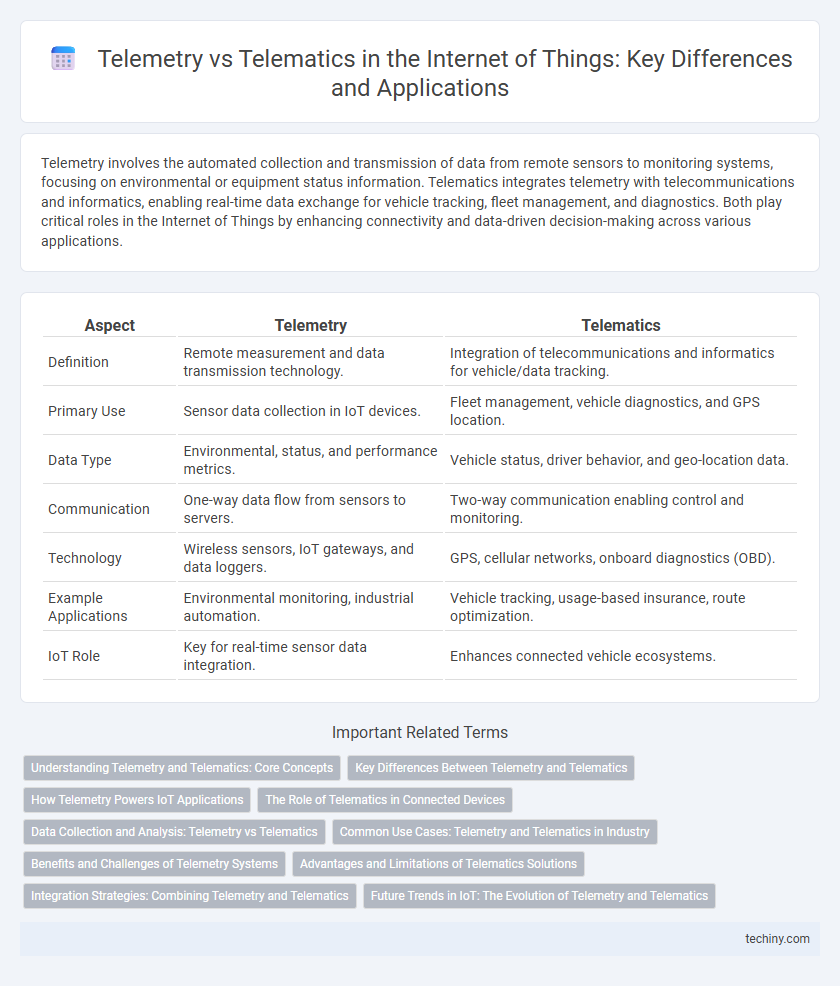Telemetry involves the automated collection and transmission of data from remote sensors to monitoring systems, focusing on environmental or equipment status information. Telematics integrates telemetry with telecommunications and informatics, enabling real-time data exchange for vehicle tracking, fleet management, and diagnostics. Both play critical roles in the Internet of Things by enhancing connectivity and data-driven decision-making across various applications.
Table of Comparison
| Aspect | Telemetry | Telematics |
|---|---|---|
| Definition | Remote measurement and data transmission technology. | Integration of telecommunications and informatics for vehicle/data tracking. |
| Primary Use | Sensor data collection in IoT devices. | Fleet management, vehicle diagnostics, and GPS location. |
| Data Type | Environmental, status, and performance metrics. | Vehicle status, driver behavior, and geo-location data. |
| Communication | One-way data flow from sensors to servers. | Two-way communication enabling control and monitoring. |
| Technology | Wireless sensors, IoT gateways, and data loggers. | GPS, cellular networks, onboard diagnostics (OBD). |
| Example Applications | Environmental monitoring, industrial automation. | Vehicle tracking, usage-based insurance, route optimization. |
| IoT Role | Key for real-time sensor data integration. | Enhances connected vehicle ecosystems. |
Understanding Telemetry and Telematics: Core Concepts
Telemetry involves the automatic measurement and wireless transmission of data from remote sensors to centralized systems for monitoring and analysis. Telematics combines telecommunications and informatics to provide real-time, location-based services and vehicle diagnostics by integrating GPS technology and data communication. Understanding telemetry focuses on sensor data collection, while telematics emphasizes actionable insights through data integration and connectivity within IoT ecosystems.
Key Differences Between Telemetry and Telematics
Telemetry involves the automated collection and transmission of data from remote sensors or devices, primarily focusing on monitoring environmental or operational conditions. Telematics integrates telemetry with GPS technology and data analytics to provide real-time location tracking, vehicle diagnostics, and driver behavior insights. The key difference lies in telemetry's emphasis on data measurement and transmission, while telematics combines this data with geographic information for comprehensive fleet management and decision-making.
How Telemetry Powers IoT Applications
Telemetry powers IoT applications by enabling real-time data collection and transmission from remote sensors to central systems, facilitating monitoring and control. It supports various industries like agriculture, healthcare, and manufacturing by providing continuous insights into environmental conditions, equipment status, and patient vitals. The integration of telemetry in IoT enhances efficiency, predictive maintenance, and automated decision-making, distinguishing it from telematics, which primarily focuses on vehicle and asset tracking using GPS data combined with telemetry information.
The Role of Telematics in Connected Devices
Telematics in connected devices integrates telecommunications and informatics to enable real-time data transmission and analytics, enhancing vehicle fleet management, asset tracking, and remote monitoring. Unlike telemetry, which primarily focuses on data collection and transmission, telematics combines GPS technology with onboard diagnostics for comprehensive insights and predictive maintenance. This synergy drives operational efficiency, improved safety, and cost savings across industries relying on Internet of Things (IoT) ecosystems.
Data Collection and Analysis: Telemetry vs Telematics
Telemetry involves remote data collection and real-time monitoring of devices, transmitting sensor readings such as temperature, pressure, and location to centralized systems for analysis. Telematics extends beyond telemetry by integrating GPS data with advanced analytics to provide insights on vehicle or asset performance, driver behavior, and route optimization. The combination of data collection and analysis in telematics enables predictive maintenance and enhanced operational efficiency in IoT applications.
Common Use Cases: Telemetry and Telematics in Industry
Telemetry in the Internet of Things (IoT) primarily involves remote monitoring of environmental conditions, equipment performance, and sensor data to optimize industrial processes and predictive maintenance. Telematics extends these capabilities by integrating GPS and vehicle data for fleet management, asset tracking, and ensuring operational efficiency in logistics and transportation sectors. Both telemetry and telematics play crucial roles in smart manufacturing, supply chain automation, and improving overall industrial productivity through real-time data analytics.
Benefits and Challenges of Telemetry Systems
Telemetry systems enable real-time remote monitoring and data collection across IoT devices, offering enhanced operational efficiency, predictive maintenance, and reduced downtime. Key benefits include improved accuracy in measuring environmental variables and seamless integration with cloud platforms for data analytics. Challenges involve data security risks, network reliability issues, and the complexity of managing large-scale telemetry infrastructures in diverse IoT environments.
Advantages and Limitations of Telematics Solutions
Telematics solutions offer real-time data transmission and advanced analytics, enabling enhanced fleet management, vehicle diagnostics, and driver behavior monitoring. These systems improve operational efficiency and safety while reducing costs through predictive maintenance and optimized routing. However, telematics face limitations such as high installation costs, data privacy concerns, and reliance on consistent network connectivity for accurate data reporting.
Integration Strategies: Combining Telemetry and Telematics
Integration strategies for combining telemetry and telematics involve unifying sensor data collection with advanced vehicle or asset tracking systems to enhance real-time decision-making in the Internet of Things ecosystem. Leveraging cloud platforms and edge computing enables seamless data aggregation and analytics from telemetry sensors and telematics devices, optimizing operational efficiency and predictive maintenance. Implementation of standardized communication protocols such as MQTT and CAN bus ensures interoperability between telemetry and telematics components, facilitating scalable IoT solutions.
Future Trends in IoT: The Evolution of Telemetry and Telematics
Future trends in IoT reveal a convergence of telemetry and telematics through advanced sensor networks and real-time data analytics, enhancing predictive maintenance and asset management across industries. The integration of AI and 5G connectivity drives increased accuracy in telematics systems, optimizing vehicle tracking and fleet management while expanding telemetry applications beyond traditional boundaries. These developments accelerate digital transformation in smart cities, transportation, and industrial automation, creating seamless data ecosystems for improved operational efficiency.
telemetry vs telematics Infographic

 techiny.com
techiny.com